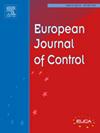缆索驱动并联机器人的增强约束最优滑模控制
IF 2.6
3区 计算机科学
Q2 AUTOMATION & CONTROL SYSTEMS
引用次数: 0
摘要
本文介绍了缆索驱动并联机器人(CDPRs)滑模控制(SMC)的新方法,其特点是创新的非线性滑动面公式。本文首先考察了动态不确定性和外部干扰下的CDPR模型。除了标准误差方程曲面外,还在常规滑模控制的框架内提出并分析了两个精心选择的非线性曲面-一种新颖的奇指数曲面和双曲正切曲面。此外,认识到传统SMC方法在平移自由度和旋转自由度的cdpr中由于不确定性和干扰而造成的潜在效率损失,开发了一种鲁棒性增强方法。这种方法确保了在包含平移和旋转自由度的系统中有效的电缆张力管理。利用李雅普诺夫定理,对这三种滑动曲面的渐近稳定性和鲁棒性进行了严格的分析。此外,对每种控制策略在各种不确定情况下的三个滑动面到达时间进行了评估。为了验证理论结果,对不同不确定度下的6 dof空间CDPR进行了模拟。仿真结果显示了三种表面在不同不确定度条件下的比较性能,并根据具体的性能标准进行了评估。本文章由计算机程序翻译,如有差异,请以英文原文为准。
Enhanced constrained optimal sliding mode control for cable-driven parallel robots
This paper introduces novel methodologies in Sliding Mode Control (SMC) for Cable-Driven Parallel Robots (CDPRs), featuring innovative nonlinear sliding surface formulations. The study commences with an examination of the CDPR model under dynamic uncertainties and external disturbances. In addition to the standard error equation surface, two carefully selected nonlinear surfaces—a novel odd-exponential surface and a hyperbolic tangent surface—are proposed and analyzed within the framework of conventional sliding mode control. Furthermore, recognizing the potential efficiency loss of conventional SMC approaches in CDPRs with both translational and rotational Degrees of Freedom (DoFs) due to uncertainties and disturbances, a robustness enhancement approach is developed. This approach ensures effective cable tension management in systems encompassing both translational and rotational DoFs. The asymptotic stability and robustness of all three sliding surfaces are rigorously analyzed using the Lyapunov theorem, both in conventional SMC and in the proposed robustness enhancement approach. Additionally, the reaching times of the three sliding surfaces are evaluated under various uncertainty scenarios for each control strategy. To validate the theoretical findings, simulations are conducted on a 6 DoFs spatial CDPR under different levels of uncertainty. The simulation results reveal the comparative performance of each of the three surfaces under different uncertainty conditions, evaluated based on specific performance criteria.
求助全文
通过发布文献求助,成功后即可免费获取论文全文。
去求助
来源期刊

European Journal of Control
工程技术-自动化与控制系统
CiteScore
5.80
自引率
5.90%
发文量
131
审稿时长
1 months
期刊介绍:
The European Control Association (EUCA) has among its objectives to promote the development of the discipline. Apart from the European Control Conferences, the European Journal of Control is the Association''s main channel for the dissemination of important contributions in the field.
The aim of the Journal is to publish high quality papers on the theory and practice of control and systems engineering.
The scope of the Journal will be wide and cover all aspects of the discipline including methodologies, techniques and applications.
Research in control and systems engineering is necessary to develop new concepts and tools which enhance our understanding and improve our ability to design and implement high performance control systems. Submitted papers should stress the practical motivations and relevance of their results.
The design and implementation of a successful control system requires the use of a range of techniques:
Modelling
Robustness Analysis
Identification
Optimization
Control Law Design
Numerical analysis
Fault Detection, and so on.
 求助内容:
求助内容: 应助结果提醒方式:
应助结果提醒方式:


